|
November 2011 - February 2012 |
| |
|
|
 |
|
 |
| |
Publisher:
Chairman Ching-Fuh Lin Editors:
Professor I-Chun Cheng, Ms. Hsiao-wen Lin March 15,
2012 |
| |
|
 |
|
We would like to congratulate Gong-Ru
Lin, GIPO professor, on his winning of
the National Science Council's
Department of Engineering and Applied
Sciences' 2009 and 2010 “Excellent
Electronic Engineering, Computer Science
and Communication Poster Exhibition in
Performance Presentation of Applied
Technique and Knowledge
Industry-University Cooperation Program"
award.
Congratulations! GIPO
Professor Chung-Chih Wu receives the
2011 Outstanding Electrical Engineering
Professor Award.
We would like to
congratulate Po-Sheng Wang, a GIPO Ph.D.
student, on his winning, under the
direction of GIPO Professor Chih-I Wu,
of 2011 CTCI Foundation Technology
Scholarship.
Congratulations! GIPO
Professor Jr-Hau He receives the "IUPAC
(International Union of Pure and Applied
Chemistry) Prof. Jiang Novel Materials
Youth Prize".
Congratulations! GIPO
Professor Jr-Hau He receives the "2011
Electronics Devices and Materials
Association's Outstanding Youth Prize".
We would like to
congratulate Jr-Hau He, GIPO professor,
on his winning of "the 1st
Youth Photonics Engineering Award
(originally named: Youth Optics
Engineering Award)" in Taiwan Photonics
Society's 2011 optics award.
We would like to
congratulate those students who
participated in the 2011 International
Photonics Conference, held at National
Cheng Kung University during Dec. 8~10,
2011, on their excellent achievements
and on the prizes awarded!
|
Prize Winner |
Prize |
Adviser |
|
Jen-Tang Lu |
IPC 2011 Student Oral
Paper Award (Master student) |
Chi-Kuang Sun |
|
Yuan-Fu Tsai |
IPC 2011 Student Oral
Paper Award (Master student) |
Chi-Kuang Sun |
|
Szu-Chi Yang |
IPC 2011 Student Oral
Paper Award (Ph.D. student) |
Chi-Kuang Sun |
|
Yu-Chieh Chi |
IPC 2011 Student Oral
Paper Award (Ph.D. student) |
Gong-Ru Lin |
Po-Sheng Wang |
IPC 2011 Student Oral
Paper Award (Ph.D. student) |
Chih-I Wu |
|
Wei-Hsuan Tseng |
IPC 2011 Student Oral
Paper Award (Ph.D. student) |
Chih-I Wu |
|
Hsiang-Chun Wei |
IPC 2011 Student Oral
Paper Award (Ph.D. student) |
Guo-Dung Su |
|
Chia-Hung Liao |
IPC 2011 Student Poster Paper Award
(Master student) |
Chih-Chung Yang, Yean-Woei Kiang |
|
Hong-Jhang Syu |
IPC 2011 Student Poster Paper Award
(Ph.D. student) |
Ching-Fuh Lin |
|
Chung-Lun Wu |
IPC 2011 Student Poster Paper Award
(Ph.D. student) |
Gong-Ru Lin |
|
Chih-Hsien Cheng |
IPC 2011 Student Poster Paper Award
(Ph.D. student) |
Gong-Ru Lin |
|
Ming-Hsiang Lin |
IPC 2011 Student Poster Paper Award
(Ph.D. student) |
Chung-Chih Wu |
|
Congratulations to
Ph.D. student Chun-Lin Chang on his
winning, under the direction of Prof.
Sheng-Lung Huang, the 2011 "Defence
Industry Scholarship" from the National
Defense Industrial Development
Foundation.
We would also like to
congratulate Prof. Jr-Hau He on his
becoming a member of the Global Young
Academy (GYA).
|
|
 |
|
 |
|
| |
|
 |
|
October
“Photonics Forum” Highlights
(Compiled by Li-Chi Yao) |
|
|
Oct. 14th
(Friday), 2011, 1:20 pm |
|
Speaker: |
Prof. Azzedine Boudrioua (OSA/SPIE
fellow, Université Paris 13 –
Institut Galilée) |
|
Topic: |
Optimal Design of
Organic Laser Diode |
| |
Prof. Azzedine Boudrioua visited
GIPO on Oct. 14th (Friday) and
delivered a speech, ”Optimal Design
of Organic Laser Diode”, at room
205, Min-Da Hall. This was the 2nd
time he visited GIPO. His speech was
marvelous, well-considered in every
respect and he interacted well with
the audience. GIPO Professors and
students participated in this event
with enthusiasm and gained a lot
from it.
|
| |
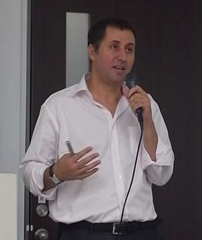 |
|
Prof. Azzedine
Boudrioua |
|
|
|
Oct. 28th
(Friday), 2011, 3:30 pm |
|
Speaker: |
Director Te-Sheng Wei
(movie director) |
|
Topic: |
About the Movie -
Seediq Bale |
| |
Director Te-Sheng Wei visited GIPO
on Oct. 28th (Friday) and
delivered a speech on “About the
Movie - Seediq Bale” at the
auditorium of the 1st
Student Activity Center. Born in
1969, he took part in the production
of several movies and TV programs
during 1993 and 2002, including:
"The Breath", by the Japanese
director Kaizo Hayashi. "Mahjong",
by director Edward Yang, and "Double
Vision", by director Kuo-Fu Chen
(Wei was the planner and assistant
director in this film). Meanwhile,
he has also directed several movies,
including: "About July", in 1999,
which won the Dragons and Tigers
special prize at the Vancouver
International Film Festival
(Canada), and "Cape No.7", 2008,
which was the best-selling Taiwanese
movie in Taiwan history, and won the
Gold Horse Award for that year's
outstanding movie, audience-chosen
best film and the best supporting
actor as well as 1st
prizes at international film
festivals in Hawaii and Japan. In
2011, he completed "Seediq Bale",
which was nominated for the 68th
Venice film festival. This symposium
was wonderful, all seats were
occupied. Students asked questions
with enthusiasm and interacted with
Director Wei. All the participants
benefited greatly from this
experience.
|
| |
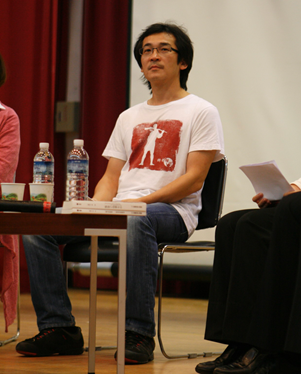 |
|
Director Te-Sheng
Wei |
|
|
November
“Photonics Forum” Highlights
(Compiled by Li-Chi Yao) |
|
|
Nov. 4th
(Friday), 2011, 3:30 pm |
|
Speaker: |
Dr. Steven Yang
(Oclaro, Inc.) |
|
Topic: |
Coherent Optical
Communication: An Industrial
Perspective |
| |
Dr. Steven Yang visited GIPO on Nov.
4th (Friday), and
delivered a speech on “Coherent
Optical Communication: An Industrial
Perspective”, at auditorium 105 of
EE II Building. His speech was
fascinating, well-considered in
every respect and he interacted well
with the GIPO professors and
students who took part in this
event. The participants attended
with great interest and benefited
greatly.
|
| |
|
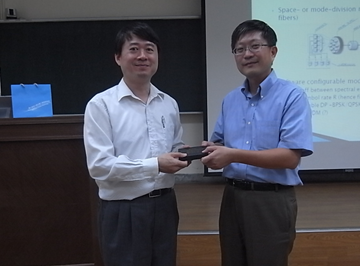 |
|
A photo of
Prof. Sheng-Lung Huang (left),
the host of this speech, and Dr.
Steven Yang |
|
|
|
Nov. 11th
(Friday), 2011, 3:30 pm |
|
Speaker: |
Dr. Ming-June
Chow
(General Manager, Epistar
Corporation) |
|
Topic: |
LED Illuminates the
Future |
| |
Dr. Ming-June Chow visited GIPO on
Nov. 11th (Friday), and
delivered a speech on “LED
Illuminates the Future”, at
auditorium 101, Barry Lam Hall. His
speech was interesting. GIPO
students participated with
enthusiasm and benefited greatly
from the experience.
|
| |
|
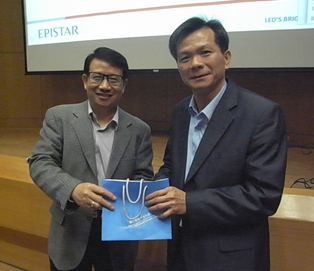 |
|
A photo of
Chairman Ching-Fuh Lin (left),
the host of this speech, and Dr.
Ming-June Chow |
|
|
|
Nov. 25th
(Friday), 2011, 3:30 pm |
|
Speaker: |
Prof. Sooder Yao
(Technical Physics Department,
Physics College, Peking University) |
|
Topic: |
The Study of Thin
Film Materials' Microstructure and
Elastic Strain, Using Nucleus
Analysis Technology |
| |
Prof. Sooder Yao visited GIPO on
Nov. 25th (Friday), and
delivered a speech: “The Study of
Thin Film Materials' Microstructure
and Elastic Strain, Using Nucleus
Analysis Technology”, at auditorium
101, Barry Lam hall. Her speech was
splendid, well-considered and he
interacted well with GIPO professors
and students. All the participants
attended with enthusiasm and
benefited greatly.
|
| |
|
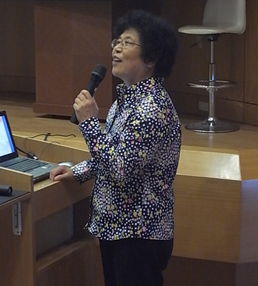 |
|
Prof. Sooder
Yao |
|
|
December
“Photonics Forum” Highlights
(Compiled by Li-Chi Yao) |
|
|
Dec. 16th
(Friday), 2011, 3:30 pm |
|
Speaker: |
Prof. Yuan-Hui Hu
(Department of Communication,
National Chung Cheng University) |
|
Topic: |
Technology = A
Beautiful New World? - A Reflection
From the Communication Domain |
| |
Prof. Yuan-Hui Hu visited GIPO on
Dec. 16th (Friday), and
delivered a speech, “Technology = A
Beautiful New World? - A Reflection
From the Communication Domain”, at
auditorium 101, Barry Lam Hall. His
speech was fascinating,
well-considered in every respect and
he interacted well with GIPO
professors and students.
Participants were very enthusiastic
at the event, and everyone benefited
greatly.
|
| |
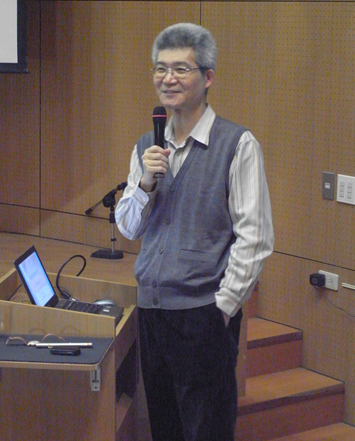 |
|
Prof. Yuan-Hui Hu |
|
|
|
Dec. 23rd (Friday), 2011,
3:30 pm |
|
Speaker: |
Dr. Taya Chu
(Institute for Microstructural
Sciences, National Research Council,
Canada) |
|
Topic: |
Development of High
Performance Organic Photovoltaics |
| |
Dr. Taya Chu visited GIPO on Dec. 23rd
(Friday), and delivered a speech,
“Development of High Performance
Organic Photovoltaics”, at
auditorium 101, Barry Lam Hall. Dr.
Chu's speech was splendid; GIPO
professors and students flocked to
his speech and gained a lot from the
event.
|
| |
 |
|
Dr. Taya Chu |
|
|
|
Dec. 30th
(Friday), 2011, 3:30 pm |
|
Speaker: |
Prof. Devki N.
Talwar
(Chair of Department of Physics,
Indiana U of Pennsylvania (IUP)) |
|
Topic: |
Phonons, Defects
and Electronic Properties of Modern
Compound Semiconductors: SiC, III-V,
Dilute Nitrides and Related
Materials |
| |
Prof. Devki N.Talwar visited GIPO on
Dec. 30th (Friday), and
delivered his speech on "Phonons,
Defects and Electronic Properties of
Modern Compound Semiconductors: SIC,
III-V, Dilute Nitrides and Related
Materials" at auditorium 101, Barry
Lam Hall. His speech was wonderful;
GIPO professors and students
participated with enthusiasm and
were eager to ask questions.
Everyone benefited greatly from it.
|
| |
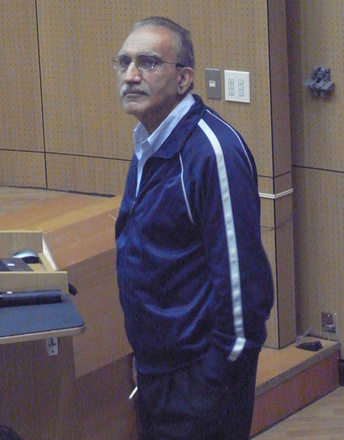 |
|
Prof. Devki N.Talwar |
|
|
 |
|
 |
|
| |
|
 |
|
~ 2011 Academic
Exchange with Nanjing University Ph.D. Students
~
(Time: October 8
- 14, 2011; Location: Nanjing
University)
Composed by Liang-Yi Chen, GIPO Ph.D.
student, captain of NTU team
On Oct.10,
2011, the 100 years' birthday of the Republic of
China, we arrived at Nanjing, the former capital
of the R.O.C. For both sides' students and
professors to meet and interact in such
circumstances, the significance is
extraordinary.
I was very
happy to be able to attend the 2011 exchange
between GIPO and NU Physics College. I had heard
of this event before and felt honored, and a bit
nervous, being a member and the captain of our
team, responsible for contacting NU in dealing
with students' affairs. Hereunder, I would like
to share with you firstly, my experience and
what I've learned in performing my duty;
secondly, what I've learned after having
attended this event.
While thinking
of attending this event, I learned some of its
history from Ms. Hsiao-Wen of the GIPO office.
This is the 4th time of the GIPO and
NU Physics College's exchange. Every year, each
university takes turns to visit the other. Last
year, NU came to Taiwan, and therefore, we
visited them this year. In addition to academic
seminars, there are cultural tours, visiting
each other's places of historic interest and
scenic beauty.
As guests, we
were more relaxed in the preparation for this
event. All schedules were arranged by 3 young NU
teachers, Liang Sun, Gang Zhao and Xiang Xiong.
Among them, Xiang Xiong came to visit us as a
student last year; after having graduated this
year, he is now a NU teacher and NU's contact
person for this event. He was also my main
contact. I have since realized that the
aforesaid 3 teachers are more like lecturers
than professors who could accept students as
disciples. They are younger as well.
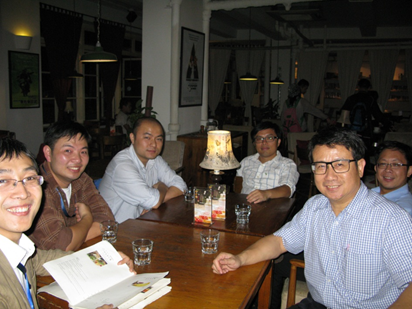 |
|
(from left)
Teacher Liang Sun, Teacher Gang Zhao, Teacher
Xiang Xiong, Professor Jr-Hau He, Chairman
Ching-Fuh Lin, and Vice Chairman Chih-I Wu;
taken at the dinner restaurant on the 1st
day of arrival |
Our team
members met 3 times before heading for Nanjing.
In the 1st meeting, each member
provided a brief self-introduction, including
which laboratory he/she came from and his/her
field of study. Then each of us was assigned to
a post on the team, and all members discussed
our flight schedules. In the discussion, some
said that mainland airlines were not safe
enough; however, there were no Taiwanese airline
flights that matched our schedule. In the end,
we had no alternative but to take mainland's
East Airline. After having taken East Airline, I
feel that taking off and landing were OK, but
the aircraft departed for more than half an hour
late, and most members said the service of the
flight crew was quite poor. Consequently, I
would suggest that, if scheduling allows, future
members fly with a Taiwanese airline instead.
During the 2nd
meeting, I collected members' CV and summaries
of their reports, and then sent them to NU's
contact teacher - Xiang Xiong. The PowerPoint of
our reports were collected by Chung-Lun Wu, the
assistant captain of our team. Although
accompanying teachers would attend our seminars,
these seminars would be basically conducted by
students themselves. Therefore, we also selected
a host for each of the 3 seminars: they were
Chung-Lun Wu, Chun-Lin Chang and Chien-Yu Chen.
These 3 would co-host the seminars with 3 NU
students, and they were very serious about their
duties, reviewing the NU students’ reports
beforehand in order to guide and encourage
discussions.
The 3rd
meeting was basically an introductory
orientation. Our schedule was confirmed, and a
checklist for things-to-carry was made.
This was the 1st
time I visited mainland China. Some said Nanjing
is not a big city. However, walking on its
streets, I felt that it almost looked like
Taipei. It was as I had heard before; the
mainland's buildings and infrastructures are
above par, and perhaps even superior to those of
Taiwan. However, on its streets, cars would not
give way to pedestrians and horns were sounded
constantly. I then realized that Taiwanese
people were still better-mannered. With that
being said, the students we met during the
exchange and on campus were much more friendly
and polite, possibly because of their education.
In addition to
learning a great deal during our academic
exchange, we also were impressed greatly by the
grand scenery of Mt. Huang and the ruins of an
ancient Huay-Sun village during the cultural
tours. In addition to interacting with NU
students during this week, I believed that it's
even more important that our own members got to
know each other better than ever before after
this event. Every one of us came back enriched.
I would suggest you join the team in the future
if you have the opportunity.
 |
|
A
group photo of the Ph.D. students of our team |
Composed by Hsiang-Chun Wei, GIPO Ph.D.
student
I was honored
to be able to attend the 4th exchange
with Nanjing University's doctoral students.
This time, Nanjing University expanded the event
into a "2011 Nationwide Doctoral Students'
Leading Edge Forum of Condensed Matter and
Optoelectronic physics, and the 4th
Cross-strait Doctoral Students' Forum".
Therefore, besides NU and GIPO, there were also
students from Soochow University, Sun Yat-sen
University, Nankai University, Shanghai Jiao
Tong University, Nanjing University of Science &
Technology, Whyyoung Engineering College and
Tsinghua University. Students made use of this
opportunity to exchange ideas about research and
life.
First of all,
we would like to thank NU's teachers and
students for their kind hospitality, which made
this event not only a successful academic
exchange but also a precious historical and
cultural journey. We, students, accompanied by
Chairman Ching-Fuh Lin, Vice Chairman Chih-I Wu,
Professor Zhe-Chuan Feng, and Professor Jr-Hau
He, had a wonderful time enjoying these 7 days'
activities. On the 1st day, the 4:30
pm plane did not start boarding until almost 6
pm, and arrived at Nanjing Lukou International
Airport at almost 8 pm, and this delay kept the
receiving NU teachers Liang Sun, Gang Zhao and
Xiang Xiong waiting for a long time. On the bus,
Liang Sun briefed us on the schedules of the
next few days and Gang Zhao, along the way,
introduced to us the geographical environment
and historical background of Nanjing.
During the
next two days of the seminar, through the guest
reports and student exchange research reports,
we were deeply impressed by mainland students'
conscientiousness about theories and fluency in
logic reasoning, giving us a lot to learn from.
In daily
conversations with the mainland students, we
often talked about things like the educational
system, work, entertainment, traffic, food etc.,
and seldom talked about the sensitive subjects
between both sides. Hereunder, I would like to
elaborate on the above-mentioned things.
The mainland's
educational system requires 3-year study for
master or doctor degree; however, Taiwan's
system requires 2-year and at least 4-year
studies to earn master and doctor degrees,
depending on each student's accomplishment.
Their doctor graduates could stay in the same
school and work as a lecturer, which is
equivalent to our assistant professor. One thing
is unique in their system: the mainland's
professors do not have as much autonomy as we
do. In mainland China, a head professor leads a
group of professors to do research.
With regard to
work, the starting salary of their master
graduates in industries is about 6,000 to 8,000
RMB and that of doctor graduates in industries
in big cities is 10,000 to 12,000 RMB. However,
industries in small cities can not afford to pay
for the aforesaid doctor graduate's salary.
Doctor graduates have to accept a master
graduate's salary if they wish to work in small
cities. If doctor graduates teach in school,
their salaries would be less than 4,000 RMB.
As for
entertainment, mainland students are very
similar to Taiwanese students. They like
listening to and singing pop songs, watching
idol dramas and surfing the internet to pick up
new information and share inner thoughts. What
makes me feel happiest is that they love
Taiwan's dramas more than we do. Because of the
popularization of Beijing language, except for
some retroflexion when they talk, we are unable
to hear any difference from us when they sing
Taiwan's pop songs. In addition, because of
their state's policy, mainland China has blocked
many websites and softwares. We use mostly msn
and facebook for web chatting, but mainland
students use QQ and www.renren.com instead. Use
their websites if you would like to get to know
them better. Mainland China has many of their
own sport equipment brands, such as Lining or
Annta sports. We realized that they seldom buy
well-known European or American merchandise,
which reminded us that Taiwanese students should
learn from them and buy more MIT products.
Nanjing's
transportation is convenient and smooth. There
are lots of buses and taxis on the road. The
interior designs of their buses are the same as
those of Taiwan's air-conditioned buses. The
starting cost of taking a taxi is 9 RMB, which
is comparatively less expensive. However,
passengers have to pay 2 RMB more for fuel tax
if they ride during nighttime. NU students ride
bicycles on campus, same as we do. On top of
that, there are some electric bicycles which are
quiet and not too fast. But, because it does not
have an engine to make noise, electric bicycle
riders seem to enjoy sounding their horn in a
long and continuous way to make sure everyone
hears them. NU students told us that because, in
the mainland, no one is afraid of vehicles,
riders have no alternative but to do this to
protect themselves.
The hotel we
stayed at is "Nanyuan", located in NU's campus,
which is used for the specific purpose of
receiving foreign guests. Its facilities are
quite good, including internet, TV and bathroom
facilities. We would like to thank NU for going
out of their way to provide us with power outlet
adapters. The shower stall is semi-transparent
and quite “atmospheric”, and this made us a
little embarrassed. But, really, there is
nothing to be embarrassed about since we’re all
guys. We were also told that there is a women’s
dormitory by Nanyuan, which is the biggest in
Asia, and the men always look forward to
visiting at the beginning of each semester, when
they can use the excuse of helping girls move
in. NU's female students have said that because
there are no drapes in their dormitory, they
have to paste wallpapers on the window or hang
clothing by it. In addition, because there is no
hot water in their dormitory, students have to
bring their soaps and washbasins during evening
to bathe at the student bathhouse. Although I
considered taking a shower in the student
bathhouse for the unique experience, after a
long day's activities, it was always closed
before I was free.
Concerning
food, we would like to thank NU for providing us
with an abundance of delicious dishes during
mealtimes. NU students introduced famous local
dishes to us, such as "duck’s blood & green bean
noodle hot pot", "rock sugar glutinous rice
lotus root" and "pressed, dried & salted duck".
The most famous local food is "Yangcheng Lake
Daisy Crab”. As a poem reads: "When Autumn wind
blows, I follow the smell of crab here", the
Yangcheng Lake Daisy Crabs have grown fat with
roe and meat during this time. What interests us
the most is that NU students have told us that
there are 3 kinds of Daisy Crabs: locally-born
and bred Daisy Crab, foreign-born and
locally-bred Daisy Crab, and lakeside-bred Daisy
Crab. Sounds interesting, doesn’t it? In
addition, we witnessed the great drinking
capacity of Deputy Dean Zhenlin Wang. Our
Chairman Ching-Fuh Lin can also hold his drink
quite impressively.
Since it was
the centennial birthday of R.O.C. and the
centennial anniversary of national father
Yat-Sen Sun's 1911 revolution when we were
visiting NU, it meant a lot to make the
pilgrimage to Yat-Sen Sun's tomb at that time.
On a platform up the stairs of his tomb, there
are two big tripods, on the sides of those
tripods; there are some bullet holes, which were
left by Japanese soldiers when they invaded
China during World War II. A proverb says: "The
small and weak will be bullied, and those who
fall behind will be beaten." NU students have
told us that this proverb comes from "Quotations
from Chairman Mao Tse-Tung", and worth some
reflection. Speaking of quotations, like us,
mainland students have to take dogma thought
classes. Nevertheless, like us again, they have
also gradually come to ignore the strictness of
these things and just take them as references.
After 7 days
of exchange and time spent together, as usual,
both teams chose one member of the other for the
congeniality award. Our captain Liang-Yi Chen
and NU's Ming-Xue Li, who have accompanied us
all these days, won the honorable prize.
In conclusion,
we would like to thank GIPO for providing us
with this excellent opportunity to get to know
so many mainland friends and establish better
relationships with other GIPO students. We have
also gained a lot in academic achievements
through the interaction. Above all, we would
like to thank NU teachers and students for their
hospitality. This was truly a worthwhile and
greatly beneficial trip.
 |
|
Nanyuan hotel, NU |
 |
|
A group photo
taken at a subway station on route to Confucius'
temple |

 |
|
A group photo
of student Yi-Jiun Chen
(top left, bottom left) and mainland students -
the winners of thesis prize |

 |
|
(top) A group
photo taken in front of Yat-Sen Sun's tomb; (bottom) Bullet holes left
by Japanese soldiers during World War II |
 |
|
A
group photo taken after visiting
laboratories |

 |
|
The
congeniality award - NU winner (top right,
bottom right), GIPO winner (top left,
bottom left) |
~ The 2nd
Cross-Strait Forum on Optics and Photonics
~
(Time: November 28 - 30, 2011; Location: Barry
Lam Hall, NTU)
Composed by: Wen-Ping Chen
After having
successfully held the 1st
cross-strait photonics study camp last December,
GIPO Prof. C. C. Yang has once again held the 2nd
at Barry Lam Hall, EECS, during Nov. 28~30,
2011. At 8:30 am on Nov. 28, under the
supervision and blessing of Chao-Han Liu, former
associate dean of Academia Sinica, Tzong-Ho Bau,
vice president of NTU, and Lin-Shan Lee, dean of
EECS, the camp started its 3-day-long packed
agenda. There were 10 teachers and 24 students
(post-doctorate researchers and Ph.D. students)
from mainland's Peking University, Tsinghua
University and Nanjing University, and 20
teachers and 24 students from our National
Taiwan University, National Tsing Hua
University, National Chiao Tung University and
National Cheng Kung University attending this
camp. Its agenda includes: lessons given by
teachers, oral presentations given by the
students, and poster exhibitions, and cultural
tours. The purpose of holding this camp is to
promote both sides' academic educational
understanding and respect and to create further
cooperation opportunities. It is a new
undertaking and a learning process as well.

|
|
|
 |
|
 |
|
| |
|
 |
|
High
speed transportation of 2DEG in GaN/Ga2O3 single
nanowire MOSFET
Professor Lung-Han
Peng
Graduate Institute of Photonics and
Optoelectronics, National Taiwan
University
We reported the direct current (DC) and
radio frequency (RF) transport
properties measured on  -
GaN/Ga2O3single
nanowire (SNW)-MOSFET devices. The
devices were laterally- and
directionally- grown on (0001) sapphire
substrates using a home-built reactor
invoking the gold-catalyst
vapor-liquid-solid growth mechanism. For
a 60nm-dia. Ga2O3/GaN
SNW-MOSFET of 0.1mm
gate length and drain-source distance of
1mm,
we measured a saturation current of 160mA,
current on/off ratio of 105,
swing of 85mV/dec, transconductance of
85mS,
and cut-off frequency ft/fmax of
95/105 GHz, respectively. From these
measurements we identify the observation
of electric mitigation over the
short-channel effects such as Vt roll-off
and improvement of S factor owing to the
nanowire device aspect ratio effect
similar to their III-V planar
counterpart FET devices. These improved
transport properties were ascribed to
the high-crystallinity and abrupt
interfaces between sapphire/GaN and GaN/Ga2O3 as
verified from the high-resolution
transmission electron microscopy (HRTEM)
analysis. From a 3D diffusion and drift
model analysis, we reconstructed the
transistor’s current-voltage (I-V)
characteristics by incorporating a sheet
of high mobility (m =
1000 cm2/V-sec) electron gas
(2DEG) of 7´1012 cm-2confined
at the -
GaN/Ga2O3single
nanowire (SNW)-MOSFET devices. The
devices were laterally- and
directionally- grown on (0001) sapphire
substrates using a home-built reactor
invoking the gold-catalyst
vapor-liquid-solid growth mechanism. For
a 60nm-dia. Ga2O3/GaN
SNW-MOSFET of 0.1mm
gate length and drain-source distance of
1mm,
we measured a saturation current of 160mA,
current on/off ratio of 105,
swing of 85mV/dec, transconductance of
85mS,
and cut-off frequency ft/fmax of
95/105 GHz, respectively. From these
measurements we identify the observation
of electric mitigation over the
short-channel effects such as Vt roll-off
and improvement of S factor owing to the
nanowire device aspect ratio effect
similar to their III-V planar
counterpart FET devices. These improved
transport properties were ascribed to
the high-crystallinity and abrupt
interfaces between sapphire/GaN and GaN/Ga2O3 as
verified from the high-resolution
transmission electron microscopy (HRTEM)
analysis. From a 3D diffusion and drift
model analysis, we reconstructed the
transistor’s current-voltage (I-V)
characteristics by incorporating a sheet
of high mobility (m =
1000 cm2/V-sec) electron gas
(2DEG) of 7´1012 cm-2confined
at the  GaN/Ga2O3 interface.
It proves the origin of 2DEG confined at
the semi-polar GaN/Ga2O3 interface.
It proves the origin of 2DEG confined at
the semi-polar  GaN/Ga2O3interface
is caused by the discontinuity of the
spontaneous polarization Psp effect
to screen out the polarization-induced
fixed charge therein. Its magnitude
conforms to a law of cosine dependence (q =
62°) to the bulk GaN Psp value
of -0.029C/m2. These
observations illustrate the virtues of
using a simple architecture of Ga2O3/GaN
NW-MOSFET structure to pursue the
scaling-down issues of integrating the
III-V nano-transistors on the
silicon-based CMOS platform. GaN/Ga2O3interface
is caused by the discontinuity of the
spontaneous polarization Psp effect
to screen out the polarization-induced
fixed charge therein. Its magnitude
conforms to a law of cosine dependence (q =
62°) to the bulk GaN Psp value
of -0.029C/m2. These
observations illustrate the virtues of
using a simple architecture of Ga2O3/GaN
NW-MOSFET structure to pursue the
scaling-down issues of integrating the
III-V nano-transistors on the
silicon-based CMOS platform.
Ref: C.-W. Yu et al., Appl.
Phys. Lett. 99,
152108 (2011)
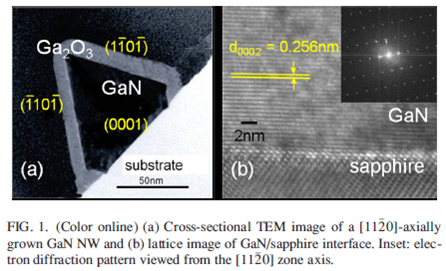 |
|
|
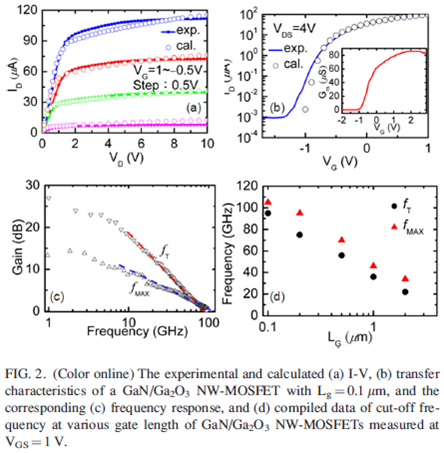 |
|
|
Development of High-Performance
Transparent and Flexible Thin-Film
Transistors Based on Oxide
Semiconductors for Displays,
Flexible Electronics and Transparent
Electronics
Professor Chung-Chih
Wu
Graduate Institute of Photonics and
Optoelectronics, National Taiwan
University
We have been dedicated to development of
oxide semiconductor thin film
transistors (TFTs) in recent years due
to their various merits, such as high
mobility in amorphous phase, low
processing temperature and transparency
etc., promising for various novel
applications. (1) We had developed
high-performance transparent oxide TFTs
(Fig. 1) based on
amorphous In-Ga-Zn-O (a-IGZO) with a
mobility m of
up to 45 cm2/V×s,
a sub-threshold swing SS of 0.4
V/decade, an on/off ratio of >107,
and good stability (small DVth of
<0.2 V after extended current
stressing). Active-matrix OLED displays
using such oxide TFTs had also been
demonstrated in a collaboration work.
(2) We had also developed
high-performance and highly flexible
a-IGZO TFTs on fully transparent
polyimide-based nanocomposite substrates
(Fig. 2) using
conventional micro-fabrication processes
that are compatible with existing
production technologies. The flexible
a-IGZO TFTs exhibited a decent m of
up to 16 cm2/V×s,
a SS of 0.4 V/decade and an on/off ratio
of >108. The devices could be
bent down to a radius of curvature of 3
mm and yet remained normally functional,
with only small changes of TFT
characteristics vs. applied strains
(compared to a-Si). (3) In addition to
device technologies, we had also
developed the physical modeling of
carrier transport and the subgap density
of states in amorphous oxides for device
simulation of oxide TFTs operated in
both the depletion/enhancement modes,
which shall be of general use for
designs of oxide TFT devices and
circuits (Fig. 3).
|
 |
|
Fig. 1. (a) Photo of transparent
oxide TFTs. (b) Output and
transfer characteristics of
transparent a-IGZO TFTs. (c)
Prototype AMOLED using a-IGZO
TFTs. |
 |
|
Fig. 2. (a) Photo of
micro-fabricated flexible a-IGZO
TFTs on transparent polyimides.
(b) Output characteristics of
flexible a-IGZO TFTs. (c)
Flexible a-IGZO TFT
characteristics vs. bending
radius. (d) Flexible a-IGZO TFT
mobility vs. strain. |
 |
|
Fig. 3. (a) Physical modeling
a-IGZO TFTs. (b) Tight fits of
measured TFT characteristics
with simulation. (c) Extracted
subgap density of states of
amorphous oxide semiconductors. |
Investigation of the diffusion
length of the cathodes in OLEDs
through the impedance
characteristics
Professor Chih-I
Wu's Laboratory
Graduate Institute of Photonics and
Optoelectronics, National Taiwan
University
For typical organic light emitting
devices (OLEDs) with the hole mobility
much larger than the electron mobility,
the impedance versus voltage (Z-V)
characteristics show a particular
behavior which can be used to
investigate many electrical properties
of the organic layers. The impedance of
these devices presents a transition from
a higher value to a lower value before
the device turns on, which indicates
that the hole transport layer (HTL)
reaches flat band and becomes conductive
first. The voltage at where this
transition occurs is named the
transition voltage, and the difference
between the transition voltage and the
turn on voltage is dependent on the
thickness of the electron transport
layer (ETL) and the density of the
accumulation charges.
In this work, devices with
systematically varied thicknesses of
ETLs and four kinds of cathode
structures were investigated. The
transition voltages versus the thickness
of the ETL characteristics in Fig. 1
show that the transition voltages of the
devices with an electron injection layer
(EIL) shift toward higher bias while the
slopes of all these devices remain
constant. The shift of the transition
voltage is proposed to result from the
diffusion of the cathode structures into
the organic layers which decreases the
effective thickness of the ETL for
capacitances. Therefore, the diffusion
length of these cathodes can be
estimated from the shift of the
transition voltages of each group of
devices.
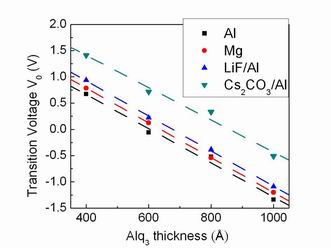 |
|
Fig.1 The transition voltage V0 versus
thickness of the ETL (Alq3)
characteristics. The film
structures of these devices are
ITO/NPB(800Å)/Alq3/cathodes. |
Tumor
detection strategy using ZnO light
emitting nano-probes
Professor Jian-Jang
Huang
Graduate Institute of Photonics and
Optoelectronics, National Taiwan
University
Traditional methods of detecting cancer
cells, such as fluorescence, have their
limits and can hardly be used for
identification during tumor resection.
Here we report an alternative tumor
detection technology using ZnO nanorods
bonded to antibodies as cancer cell
probes. Our experiment shows that
EGFR(Epidermal growth factor receptor)
can be connected to ZnO nanorods and to
EGF receptors of SCC(squamous cell
carcinoma). The cancer cell can be
recognized by the bare eye or the
optical microscope with the help of
purple light emission from ZnO/EGFR
antibody probes. On the other hand, for
cells with less expression to EGFR, in
our case HS68, no purple light was
observed as the probes were washed-off.
From the photoluminescent spectra, the
peak intensity ratio between the purple
light (from ZnO at the wavelength 377nm)
and the green band (from the
auto-fluorescence of cells) is much
higher with the presence of SCC, as
compared with HS68. The ZnO/EGFR
antibody probes have the potential to be
applied to real time surgery for tumor
cell identification. The cancer cells
will be excised with the help of purple
light emission.
Luminous-efficiency improvement of
solar-cell-integrated high-contrast
organic light-emitting diode by
applying distributed Bragg reflector
Professor Hoang-Yan
Lin
Graduate Institute of Photonics and
Optoelectronics, National Taiwan
University
Solar-cell-integrated organic
light-emitting diodes (OLEDs) were
fabricated with both high contrast ratio
and energy-recycling ability. However,
the luminous efficiency of the
integrated devices is reduced to 50% of
that of conventional top-emitting OLEDs.
A novel structure to recover the
luminous efficiency from 50% to near 85%
by applying a distributed Bragg
reflector (DBR) was demonstrated. It
saves about 40% of the electric power of
that of a device without a DBR. The
contrast ratio remains high compared to
that of conventional OLEDs. Simulations
were conducted first to prove our models
and assumptions. Then, two types of
thin-film solar cells – CdTe and CIGS
solar cells – were used. They had
different contrast ratios as well as
viewing-angle properties. Finally, the
emission spectrum was calculated to be
11 nm FWHM, which is narrower than that
for the emission spectrum of a typical
microcavity OLED and has the advantage
of having saturated colors.
|
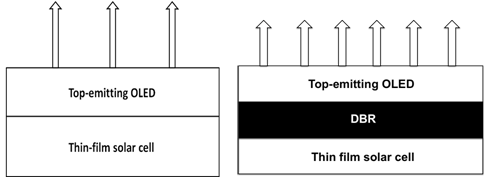 |
|
Fig. 1 (a) Concept of the
solar-cell-integrated OLED; (b)
concept of our DBR design;
integration of a DBR to enhance
the outcoupling efficiency. |
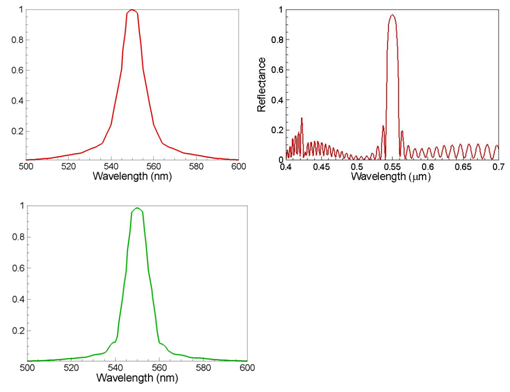 |
|
Fig. 2 (a) Input
microcavity-OLED emission
spectrum; (b) DBR reflectance of
a CdTe solar-cell-integrated
OLED; (c) output
microcavity-OLED emission
spectrum for a CdTe
solar-cell-integrated OLED. |
Full-Vectorial Finite-Difference
Mode Analysis of Step-Index
Multilayer Waveguide
Professor Yih-Peng
Chiou's
Laboratory
Graduate Institute of Photonics and
Optoelectronics, National Taiwan
University
We derive a full-vectorial
finite-difference formulation similar to
the transfer-matrix method (TMM). A
field and its derivatives are
represented with vector Y.
The field just at the left and the right
of an interface is related by a matrix MMBC,
and the vectors at homogeneous region
are related by Taylor series expansion MTSE.
As in the TMM, the vectors at different
positions are then related by
multiplying the matrices. Finally, we
can get the relation of vectors stepping
over any layers and the
finite-difference formulation is then
obtained. Such scheme has an advantage
that the grid size is not limited by the
layer thickness and can be arbitrary. It
is not necessary to put several points
to model one thin layer as before.
Therefore, the computation time and
memory are greatly saved. In the
numerical results, we will apply the
technique to two-dimensional
partially-filled and ridge waveguides
with MQW structures.
We apply this technique to a PEC-bounded
MQW-buried ridge waveguide structure as
shown in Fig. 1(a). The multilayer
structure consists of 31 barriers and 30
wells. Refractive indices of barriers
and wells are nbarr =
3.2874 and nwell =
3.3704, and widths of each barrier and
well are 12 and 7 nm, respectively.
Magnetic-field formulation, curved
corner, and non-uniform grids are used
to properly model singular field
behavior around sharp corners. Smallest Dx
and Dy
are set to 1 nm around the corners, and
maximum Dx
and Dy
are located at outer region of the
computation domain. Grid number
comparisons along x-direction are shown
in Fig. 1(b). Effective indices of
fundamental quasi-TE and quasi-TM with
respect to MQW-region and maximum
non-uniform Dx
size are investigated and illustrated in
Fig. 1(c) and (d), showing TMM-based
scheme yields less error compared with
that from non-uniform grid. These
results also indicates that the
calculated effective index increase
insignificantly with grid size of MQW
layers, since the truncation error due
to small grids in MQW layers plays minor
role in the total error.
 |
|
Fig. 1 Simulated ridge waveguide
with multilayer structure. (a)
Cross-section, (b) Number of
grids on x-direction, (c)
calculated effective indices of
fundamental quasi-TE and (d)
quasi-TM modes with respect to
grid sizes in MQW region and
maximum. |
In conclusion, we have successfully
implemented TMM-based finite-difference
waveguide analysis. Results show better
convergence performance compared with
conventional method. Simulation efforts
of structures with thin multilayers can
be greatly reduced. Since multilayer
structure is very common in various
photonic devices, this can be widely
used in various photonic design.
|
|
|
 |
|
 |
|
| |
|
|
 |
|
 |
|
|
|